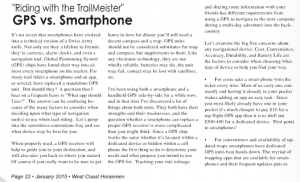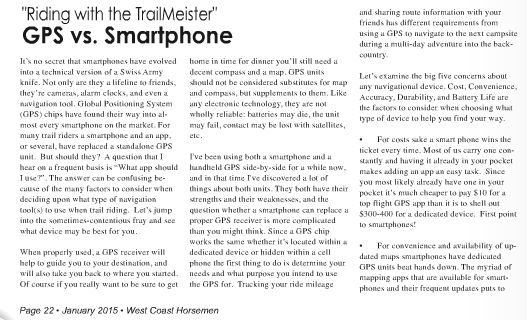 GPS vs. Smartphone for Trail Riders
GPS vs. Smartphone for Trail Riders
As published in West Coast Horsemen Magazine– Jan 2015
It’s no secret that smartphones have evolved into a technical version of a Swiss Army knife. Not only are they a lifeline to friends, they’re cameras, alarm clocks, and even a navigation tool. Global Positioning System (GPS) chips have found their way into almost every smartphone on the market. For many trail riders a smartphone and an app, or several, have replaced a standalone GPS unit. But should they? A question that I hear on a frequent basis is “What app should I use?”. The answer can be confusing because of the many factors to consider when deciding upon what type of navigation tool(s) to use when trail riding. Let’s jump into the sometimes-contentious fray and see what device may be best for you.
 When properly used, a GPS receiver will help to guide you to your destination, and will also take you back to where you started. Of course if you really want to be sure to get home in time for dinner you’ll still need a decent compass and a map. GPS units should not be considered substitutes for map and compass, but supplements to them. Like any electronic technology, they are not wholly reliable: batteries may die, the unit may fail, contact may be lost with satellites, etc.
When properly used, a GPS receiver will help to guide you to your destination, and will also take you back to where you started. Of course if you really want to be sure to get home in time for dinner you’ll still need a decent compass and a map. GPS units should not be considered substitutes for map and compass, but supplements to them. Like any electronic technology, they are not wholly reliable: batteries may die, the unit may fail, contact may be lost with satellites, etc.
I’ve been using both a smartphone and a handheld GPS side-by-side for a while now, and in that time I’ve discovered a lot of things about both units. They both have their strengths and their weaknesses, and the question whether a smartphone can replace a proper GPS receiver is more complicated than you might think. Since a GPS chip works the same whether it’s located within a dedicated device or hidden within a cell phone the first thing to do is determine your needs and what purpose you intend to use the GPS for. Tracking your ride mileage and sharing route information with your friends has different requirements from using a GPS to navigate to the next campsite during a multi-day adventure into the backcountry.
Let’s examine the big five concerns about any navigational device. Cost, Convenience, Accuracy, Durability, and Battery Life are the factors to consider when choosing what type of device to help you find your way.
 • For costs sake a smart phone wins the ticket every time. Most of us carry one constantly and having it already in your pocket makes adding an app an easy task. Since you most likely already have one in your pocket it’s much cheaper to pay $10 for a top flight GPS app than it is to shell out $300-400 for a dedicated device. First point to smartphones!
• For costs sake a smart phone wins the ticket every time. Most of us carry one constantly and having it already in your pocket makes adding an app an easy task. Since you most likely already have one in your pocket it’s much cheaper to pay $10 for a top flight GPS app than it is to shell out $300-400 for a dedicated device. First point to smartphones!
• For convenience and availability of updated maps smartphones have dedicated GPS units beat hands down. The myriad of mapping apps that are available for smartphones and their frequent updates puts to shame what is available for GPS units which mainly restrict users to proprietary, and costly, upgrades. Another point to smart phones.
• Accuracy is important and smartphones are no slouch here either. The days of cell phones relying solely on cell tower signals for positioning are long gone. Most new smartphones use not only the US department of Defense GPS satellites but also the Russian GLONASS system, which allows for faster satellite acquisition times. Newer phones have accuracy metrics that are neck and neck with GPS units. It’s a tie for this comparison!
 • Cost, convenience, and accuracy won’t matter a bit if the device isn’t rugged enough to handle the bumps and bruises of trail riding. This is an area where dedicated GPS units such as Garmin really stand out. They’re built to take the abuse that comes with the inevitable drop on the trail. Yes, there are a multitude of cases available for smartphones. They’re an added expense and for some cases their utility is “questionable”. First point to dedicated GPS units.
• Cost, convenience, and accuracy won’t matter a bit if the device isn’t rugged enough to handle the bumps and bruises of trail riding. This is an area where dedicated GPS units such as Garmin really stand out. They’re built to take the abuse that comes with the inevitable drop on the trail. Yes, there are a multitude of cases available for smartphones. They’re an added expense and for some cases their utility is “questionable”. First point to dedicated GPS units.
• Power ports on the trail are few and far between. A smartphone is a small miracle, a pocket sized computer that can accomplish almost every task. But none of its superpowers matter if it runs out of power. If you have a smartphone you’ve certainly already noticed that battery life can be an issue. Using your phone as a GPS unit only makes the battery issue much more noticeable as the applications guzzle juice. Extra battery packs can help keep the juice flowing but again they’re an added expense. Dedicated GPS units are optimized to sip from the battery so you can keep on keeping on. The point goes to dedicated GPS.
Well there you have it. Both types of devices have their strong points, as well as their challenges. For a local front country day ride I think apps are the ticket. If you’re serious about charting and way pointing the backcountry for days at a time then a dedicated GPS unit is your best bet. For now. As smart phone technology continues to evolve, and the current issues with battery life and durability are resolved I think this will change.
 At this point in time, despite everything smartphones have to offer, I believe the best bet for a trail rider is the combination of a dedicated GPS and a smartphone to use as a back up. I use this combination as an opportunity to unplug; using the GPS to track my route and keeping the cell phone available to turn on in the case of an emergency (and yes, I carry a map and compass too). It’s important to note that neither a GPS nor a smartphone can replace a solid understanding of navigational techniques. Before going on any trail ride learn the basics of how to read a map and use a compass, and how to study the topography of the trail or region before you go.
At this point in time, despite everything smartphones have to offer, I believe the best bet for a trail rider is the combination of a dedicated GPS and a smartphone to use as a back up. I use this combination as an opportunity to unplug; using the GPS to track my route and keeping the cell phone available to turn on in the case of an emergency (and yes, I carry a map and compass too). It’s important to note that neither a GPS nor a smartphone can replace a solid understanding of navigational techniques. Before going on any trail ride learn the basics of how to read a map and use a compass, and how to study the topography of the trail or region before you go.
As always for more information about trail riding, the largest database of horse trails and horse camping locations in the world and much more visit www.TrailMeister.com.


